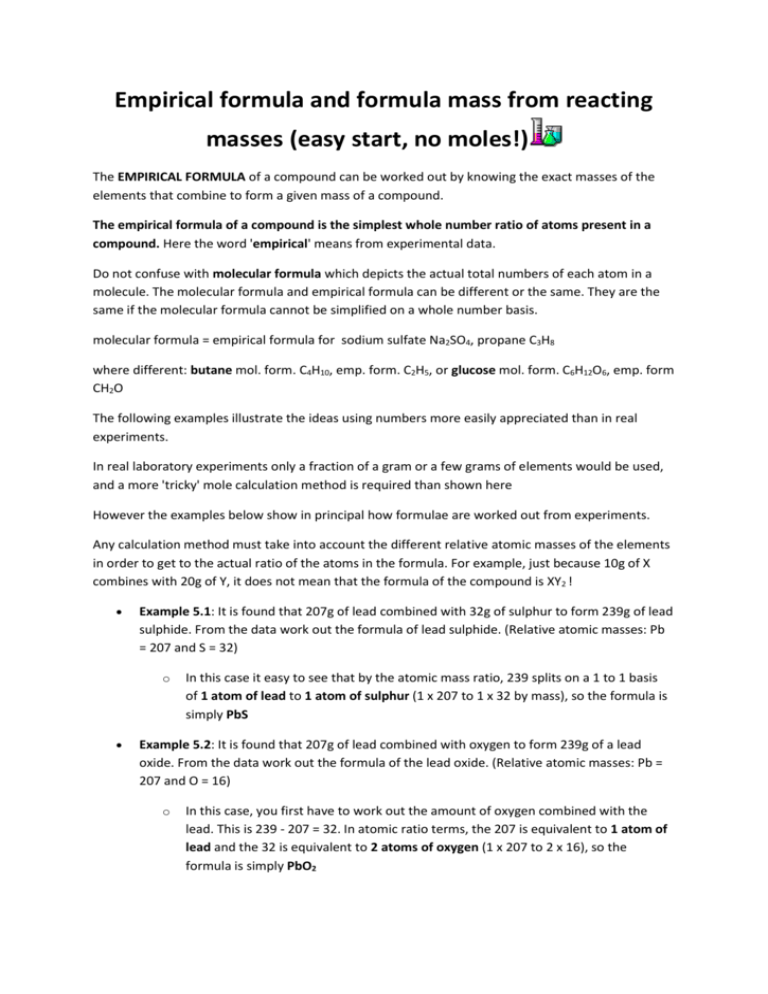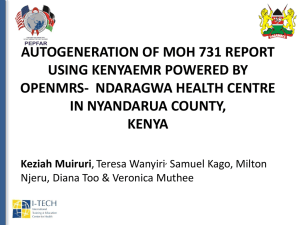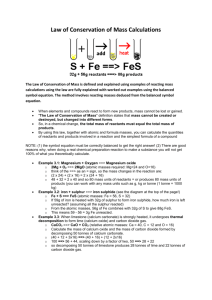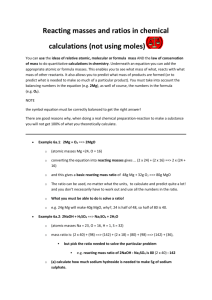Empirical formula and formula mass from reacting masses
advertisement

Empirical formula and formula mass from reacting masses (easy start, no moles!) The EMPIRICAL FORMULA of a compound can be worked out by knowing the exact masses of the elements that combine to form a given mass of a compound. The empirical formula of a compound is the simplest whole number ratio of atoms present in a compound. Here the word 'empirical' means from experimental data. Do not confuse with molecular formula which depicts the actual total numbers of each atom in a molecule. The molecular formula and empirical formula can be different or the same. They are the same if the molecular formula cannot be simplified on a whole number basis. molecular formula = empirical formula for sodium sulfate Na2SO4, propane C3H8 where different: butane mol. form. C4H10, emp. form. C2H5, or glucose mol. form. C6H12O6, emp. form CH2O The following examples illustrate the ideas using numbers more easily appreciated than in real experiments. In real laboratory experiments only a fraction of a gram or a few grams of elements would be used, and a more 'tricky' mole calculation method is required than shown here However the examples below show in principal how formulae are worked out from experiments. Any calculation method must take into account the different relative atomic masses of the elements in order to get to the actual ratio of the atoms in the formula. For example, just because 10g of X combines with 20g of Y, it does not mean that the formula of the compound is XY2 ! Example 5.1: It is found that 207g of lead combined with 32g of sulphur to form 239g of lead sulphide. From the data work out the formula of lead sulphide. (Relative atomic masses: Pb = 207 and S = 32) o In this case it easy to see that by the atomic mass ratio, 239 splits on a 1 to 1 basis of 1 atom of lead to 1 atom of sulphur (1 x 207 to 1 x 32 by mass), so the formula is simply PbS Example 5.2: It is found that 207g of lead combined with oxygen to form 239g of a lead oxide. From the data work out the formula of the lead oxide. (Relative atomic masses: Pb = 207 and O = 16) o In this case, you first have to work out the amount of oxygen combined with the lead. This is 239 - 207 = 32. In atomic ratio terms, the 207 is equivalent to 1 atom of lead and the 32 is equivalent to 2 atoms of oxygen (1 x 207 to 2 x 16), so the formula is simply PbO2 Example 5.3: It is found that 54g of aluminium forms 150g of aluminium sulphide. Work out the formula of aluminium sulphide. (Relative atomic masses: Al = 27 and S = 32). o Amount of sulphur combined with the aluminium = 150 - 54 = 96g o By atomic ratio, the 54 of aluminium is equivalent to 2 atoms of aluminium and the 96 of sulphur is equivalent to 3 atoms of sulphur. Therefore the atomic ratio is 2 to 3, so the formula of aluminium sulphide is Al2S3 Example 5.4: This is a more elaborate reacting mass calculation involving solution concentrations to arrive at a formula mass. I've used HCl and MOH as shorthand in the question and answers. o A solution of hydrochloric contained 3.65 g/dm3. A solution of a metal hydroxide of formula MOH was prepared by dissolving 5.0g of MOH in 1 dm3 of water (M is an unknown metal). 25 cm3 of the MOH solution required 22.3 cm3 of the HCl acid solution to neutralise it in a titration procedure using a pipette (MOH) and burette (HCl). The equation for the neutralisation reaction is: MOH + HCl ==> MCl + H2O Atomic masses: H = 1, Cl = 35.5, O = 16, M = ? (a) Calculate the mass of MOH neutralised in each titration. (b) Calculate the mass of HCl reacting in each titration. 3.65 x 22.3 / 1000 = 0.0814 g HCl (d) Calculate the formula mass of HCl 5 x 25 / 1000 = 0.125g MOH (remember 1 dm3 = 1000 cm3) Formula mass of HCl = 1 + 35.5 = 36.5 (c) Calculate the mass of MOH that reacts with 36.5 g HCl and hence the formula mass of MOH. If 0.125 g MOH reacts with 0.0814 g HCl z g MOH reacts with 36.5 g HCl solving the ratio, z = 36.5 x 0.125 / 0.0814 = 56.1 g MOH Therefore the experimental formula mass of MOH is 56.1 (~56) because from the equation 1 HCl reacts with 1 MOH. (d) If the metal is in the Group 1 of Alkali Metals, what is the atomic mass of M and what metal is M? If the formula mass of MOH is 56, atomic mass of M = 56 - 1 -16 = 39 The atomic mass of potassium is 39, so M is potassium. (So 'fictitious' MOH is really KOH, potassium hydroxide. You are likely to very familiar with another in the same group, sodium hydroxide NaOH)







